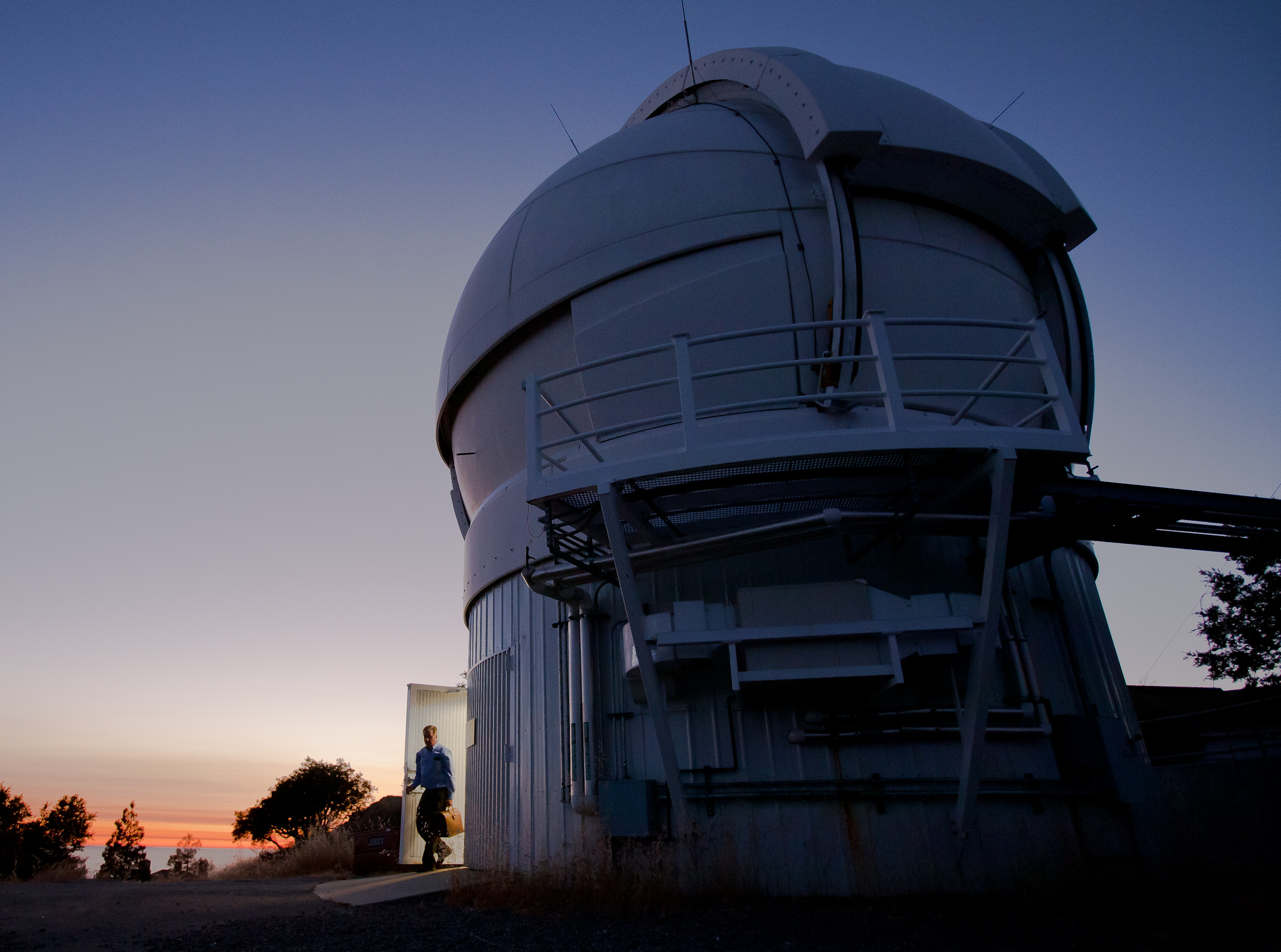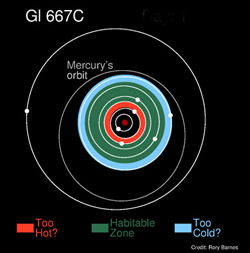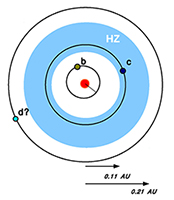Astronomer/Professor of Astronomy & Astrophysics
UCO/Lick Observatory
University of California, Santa Cruz, CA 95064
Office: ISB 343
Email: vogt@ucolick.org
Educational Background:
A.B., Physics, U.C. Berkeley, 1972
A.B., Astronomy, U.C. Berkeley, 1972
M.S., Astronomy, U. of Texas at Austin, 1976
Ph.D., Astronomy, U. of Texas at Austin, 1978
Research Interests:
Astronomical instrumentation, optical design, high-dispersion spectroscopy, exoplanet hunting
Visit Steve's Image Gallery
APF Image credit: John Russo / San Francisco Chronicle /Polaris
|

6/25/13: GJ667C: Habitable Zone Packed with Three Earth-sized Exoplanets
 Press Release Press Release
Paper: A Dynamically Packed Planetary System around GJ667C with 3 super-Earths in its Habitable Zone
Movie: GJ 667C's Orbiting Planets
Movie: Overview of GJ 667C's Planets (wmv download)
Figures: Artistic Renderings
Figure: Habitable Zone Diagrams
Catalog: Planet Habitability Laboratory
Figure: Constellation View
Reanalysis of data from Keck and other observatories combined with data from ESO's HARPS (High Accuracy Radial velocity Planet Searcher) has led to the discovery of the first extrasolar planetary system with three potentially habitable planets. GJ 667C, a nearby low-mass star, is the first star to known host several Super-earth planets in its habitable zone. In this planetary system, the habitable zone lies entirely within an orbit the size of Mercury's, much closer in than for our Sun.
"The findings are based in part on data that Paul Butler and I have taken over the past 13 years using the HIRES spectrometer on the Keck Telescope in Hawaii," said Steve Vogt, UCSC professor.
This discovery indicates that habitable planets may be more numerous that previously thought. The number of potentially habitable planets in our galaxy is much greater if we can expect to find several planets around each low-mass star.
2/2/12: GJ667C: Second Potentially Habitable Earth-sized Exoplanet Discovered
 Press Release Press Release
GJ 667C Paper
Movie: Orbital Comparison with Sun
Figure: Constellation View
Figure: Artist's Rendering
Figure: Phased Orbits
Figure: Periodograms
Figure: Top View
A planet-hunting team led by astronomers at UCSC and the Carnegie Institution of Washington has discovered a second earth-size planet orbiting a nearby star in the habitable zone where liquid water could exist. Findings are reported in a paper at arXiv.org.
"This was expected to be a rather unlikely star to host planets. Yet there they are, around a very nearby, metal-poor example of the most common type of star in our galaxy," said Vogt. "The detection of this planet, this nearby and this soon, implies that our galaxy must be teeming with billions of potentially habitable rocky planets." [More]
APF: Automated Planet Finder Telescope
- The 2.4-meter APF, currently nearing completion atop Mt. Hamilton, is the first telescope capable of detecting rocky planets that may support life. Every night it will search robotically for these planets. [More]
- Steve is the APF P.I. and leads the team that designed and is building the Levy spectrograph, optimized for speed and radial velocity precision. Spectrograph will detect changes in a star’s velocity as small as 1 meter per second--human walking speed.
- APF Homepage
- APFCam
- DOME: Construction of APF, time-lapse movie
- Images
- APF Press Release, 8/21/10
Exoplanets: Planets Beyond our Solar System
- The ultimate goal of extrasolar planet search is to discover a solar system similar to our own with earth-like planets capable of supporting life.
- Steve's roles in Exoplanet project:
- Built Hamilton spectrometer,with which many of the first planets were found
- Re-optimized the Hamilton optics in 1994 to increase the Exoplanet's rv precision from 10 m/s to 3 m/s
-
Built HIRES for Keck and incorporated Iodine cell for exoplanet work
- Principal member of the California-Carnegie Exoplanet Team from 1995-2007
- P.I. of the Automated Planet Finder facility 2001-present
- Co-leader (with Paul Butler) of the Lick-Carnegie Exoplanet Team 2007-present
- Exoplanet Press Release, 9/29/10
- Artist's images of Extrasolar Planets: Lynette Cook's illustrations
- Earthbound homepage
TMT: Thirty Meter Telescope
- TMT will be an extremely large telescope, with a 30-meter mirror comprised of 492 hexagonal-shaped segments. The spectrometer will analyze light in visible and infrared wavelengths to help astronomers answer such profound questions as "How do planets form?" and "What is the ultimate fate of our galaxy?"
- Steve completed and tendered to the TMT project a detailed design study for a Moderate-To-High-Resolution Spectrometer (MTHR) which will enable TMT to deliver the full advantage of its large aperture at first-light for high-resolution optical spectroscopy. [Read more]
- Project Manager's Reports: Status of TMT
- Spectrograph CAD rendering
- TMT homepage
HIRES: High Resolution Echelle Spectrograph
Hamilton Echelle Spectrograph
- The Hamilton Spectrograph, designed by Steve Vogt and installed at the coudé focus of Lick Observatory's Shane telescope in 1987, is still frequently used to observe distant objects.
- Steve roles in Hamilton Spectrograph Project:
- P.I. of project
- Originated the concept
- Designed the optics with Harland Epps
- Oversaw all detailed mechanical, electronic, and optical design and fabrication
- Installed and commissioned spectrograph
- Read Steve's paper on the Hamilton Spectrograph and the philosophy behind its design
- Public information about the Hamilton Spectrograph
|
 Press Release
Press Release 
 Press Release
Press Release